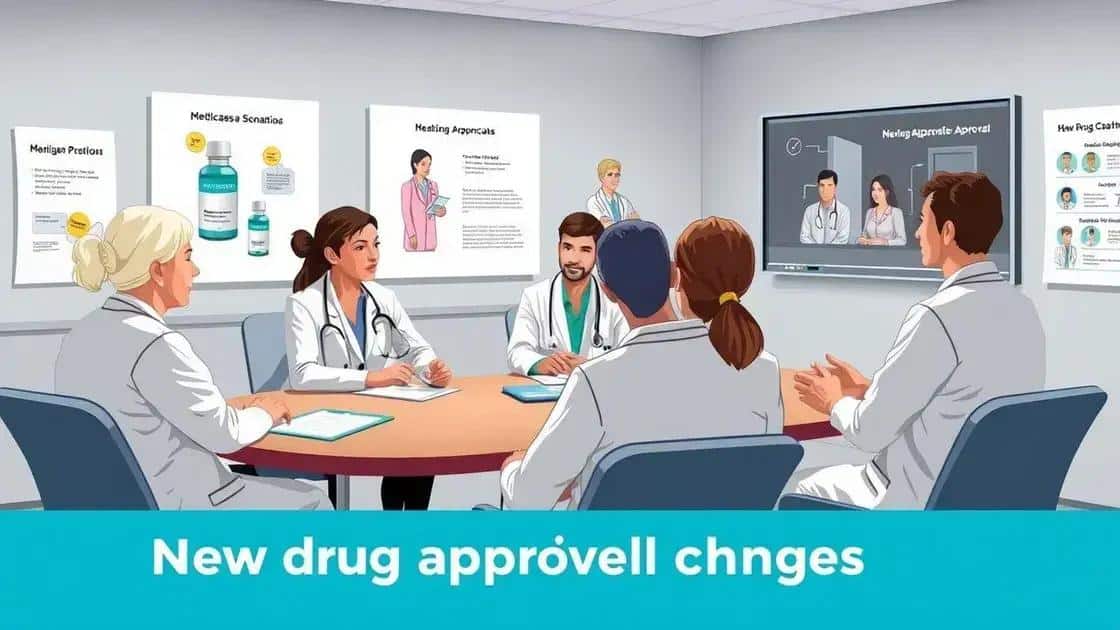The drug approval update: what you need to know

The drug approval update process involves regulatory agencies, pharmaceutical companies, healthcare professionals, and patients, focusing on expedited approvals, real-world evidence, and technology advancements to ensure safe and effective medications reach the market efficiently.
The drug approval update is becoming an essential topic for both healthcare professionals and patients alike. As new regulations come into play, it’s crucial to stay informed on how these changes may affect access to medications and treatment options.
Understanding the drug approval process
Understanding the drug approval process is vital for grasping how medications reach the market. This process ensures that new drugs are safe and effective for public use. It involves multiple stages, each designed to assess the drug’s efficacy, safety, and overall quality.
Phases of Drug Approval
The approval process is divided into several phases. Each phase plays a critical role in determining whether a drug can be sold. These are:
- Preclinical testing: This phase involves laboratory and animal studies to determine safety before human trials.
- Clinical trials: In this phase, the drug is tested on human subjects in three distinct stages to evaluate its safety and efficacy.
- Submission of application: After successful clinical trials, the manufacturer submits a New Drug Application (NDA) to regulatory agencies.
- Review process: Regulatory agencies review all data to ensure that the drug meets safety and efficacy standards.
Each of these steps is crucial to ensuring that the public health is protected. The rigorous scrutiny helps to identify any potential side effects and determine the best uses for the drug.
Factors Influencing Approval
Several factors can influence the likelihood of a drug’s approval. Among these factors are:
- Quality of data: Strong evidence from trials leads to a higher chance of approval.
- Regulatory guidelines: Understanding and adhering to these guidelines is key for a successful submission.
- Public health needs: If a drug addresses a significant unmet medical need, it may receive expedited review.
Overall, the drug approval process is designed to balance innovation while maintaining public safety. By carefully evaluating new treatments, regulatory agencies aim to ensure that each new drug can safely provide benefits for patients in need.
Recent changes in drug approval regulations
Recent changes in drug approval regulations have significantly impacted how new medications are evaluated and introduced to the market. These updates aim to streamline the process while ensuring patient safety and access to innovative therapies.
Key Regulatory Changes
Several key changes have been made to adapt to modern challenges in the healthcare landscape. The following updates are noteworthy:
- Accelerated approval pathways: Regulatory bodies now offer expedited processes for drugs that address serious conditions or unmet needs.
- Increased transparency: New rules implement clearer communication regarding clinical trial results and drug effectiveness.
- Real-world evidence: There’s a growing acceptance of using real-world data to support the approval process outside of traditional clinical trials.
These changes reflect a shift towards accommodating urgent public health needs while encouraging innovation. For instance, the expedited approval pathway allows crucial treatments to reach patients faster, especially during health crises like pandemics.
Impact on Drug Development
The updates in drug approval regulations have also influenced how pharmaceutical companies approach drug development. Understanding these regulations is vital for effective planning and execution. Companies must now focus on:
- Quick adaptation: The ability to pivot their research and development strategies based on new regulatory guidelines.
- Engagement with regulators: Early discussions with regulatory bodies can help clarify requirements and improve approval timelines.
- Patient-centric approaches: Emphasizing the importance of patient feedback in the development phase to better align with regulatory expectations.
As a result, these adjustments promote a more dynamic relationship between pharmaceutical companies and regulatory authorities, fostering innovation while prioritizing patient safety.
Impacts of drug approval updates on healthcare

The impacts of drug approval updates on healthcare are profound and wide-ranging. As regulations evolve, they shape how medications are developed, tested, and made available to patients. Understanding these impacts helps highlight the importance of keeping abreast of regulatory changes.
Benefits to Patient Access
One of the most significant effects is the enhanced access patients have to new therapies. Updates to drug approval processes often allow for faster access to essential medications. This is particularly important for conditions that require urgent treatment. Faster approvals can lead to:
- Quicker treatments: Patients can start therapies sooner, which may improve their outcomes.
- Increased availability: More drugs reaching the market means more options for patients and healthcare providers.
- Potential cost savings: Less time in approval can help reduce the overall costs associated with drug development.
These improvements in access empower patients and can encourage better health management. Medical professionals can also provide a wider range of treatment options to meet individual patient needs.
Challenges for Healthcare Providers
While there are considerable benefits, the updates to drug approval regulations can also present challenges for healthcare providers. They must navigate an ever-changing landscape of available treatments. Some challenges include:
- Staying informed: Providers need to keep up with the latest updates to understand which medications are now available.
- Adjusting treatment plans: As new medications become available, providers may need to rethink existing treatment protocols.
- Managing patient expectations: With new options comes the potential for confusion among patients about the most effective treatments.
Moreover, it is crucial for healthcare providers to communicate effectively with patients regarding these new treatment options. Educating patients about the benefits and potential risks helps them make informed decisions.
In essence, while drug approval updates can enhance patient access, they also require healthcare professionals to adapt continuously. Balancing these dynamics is essential for ensuring that patients receive the best care possible in a rapidly evolving medical landscape.
Key stakeholders involved in drug approval
Key stakeholders involved in drug approval play crucial roles at various stages of the process. Understanding who these stakeholders are helps clarify how drugs make it to market and the responsibilities each group holds.
Regulatory Agencies
Regulatory agencies are perhaps the most influential stakeholders in the drug approval process. They ensure that new medications meet safety and efficacy standards. Two of the main agencies are:
- FDA (Food and Drug Administration): In the United States, the FDA is responsible for evaluating new drugs and monitoring their safety.
- EMA (European Medicines Agency): In Europe, the EMA oversees the approval and regulation of medicines across the continent.
These organizations evaluate clinical trial data and determine whether drugs can enter the market.
Pharmaceutical Companies
Pharmaceutical companies conduct research and development for new drugs. They are responsible for funding clinical trials and gathering data needed for the approval process. Their ability to innovate and comply with regulations is critical in bringing new therapies to the public.
Healthcare Professionals
Healthcare professionals, including doctors and pharmacists, are integral in administering new drugs to patients. They need to stay informed about the latest medications available and understand their potential benefits and risks. This knowledge allows them to make informed treatment decisions.
Patients and Advocacy Groups
Patients are also vital stakeholders in the drug approval process. Their experiences and feedback can influence research priorities and regulatory decisions. Advocacy groups often represent patient interests, focusing on accessing needed therapies and raising awareness about specific diseases.
Collaboration among these stakeholders is essential for successful drug development and approval. By working together, they can ensure that the process produces safe, effective medications that meet the needs of patients.
Future trends in drug approvals
Future trends in drug approvals indicate a significant shift towards more efficient and patient-centric processes. As technology advances and healthcare needs evolve, the landscape of drug development and approval is changing rapidly.
Increased Use of Technology
Technology will play an essential role in shaping future drug approvals. This includes the use of artificial intelligence and machine learning to analyze data from clinical trials. These tools can help identify effective treatments more quickly. Additionally, data analytics can provide insights into patient responses and safety, making the approval process more efficient.
Focus on Personalized Medicine
Another important trend is the rise of personalized medicine. This approach tailors treatments to individual patient profiles. Regulators are increasingly looking at how specific genetic or environmental factors influence drug responses. With this shift, drug approvals may rely more on targeted therapies that work better for particular patient groups.
Greater Emphasis on Real-World Evidence
Currently, there is a push for incorporating real-world evidence into the drug approval process. This means using data from actual patient experiences outside of clinical trials. Such evidence can provide valuable insights into drug effectiveness and safety in diverse populations. Regulatory bodies are starting to accept this data to support new drug applications, which could speed up approvals.
Collaborative Approaches
Future drug approvals will likely also see more collaboration between stakeholders. This includes closer partnerships among pharmaceutical companies, regulatory bodies, and healthcare providers. Such collaboration can enhance the development of innovative therapies and streamline the approval process.
In summary, the trends in drug approvals are moving towards greater efficiency, patient focus, and adaptability to new scientific advancements. By embracing these changes, the healthcare system aims to ensure that patients have timely access to safe and effective medications.
FAQ – Frequently Asked Questions about Drug Approval Processes
What are the main steps in the drug approval process?
The main steps include preclinical testing, clinical trials, and submission to regulatory agencies for approval.
Who are the key stakeholders in drug approvals?
Key stakeholders include regulatory agencies, pharmaceutical companies, healthcare professionals, and patients.
How does technology impact drug approvals?
Technology, such as AI, helps analyze data faster and improves the efficiency of clinical trials and approvals.
What role does patient feedback play in drug approval?
Patient feedback is crucial in shaping drug development and ensuring the therapies meet real-world needs and effectiveness.





